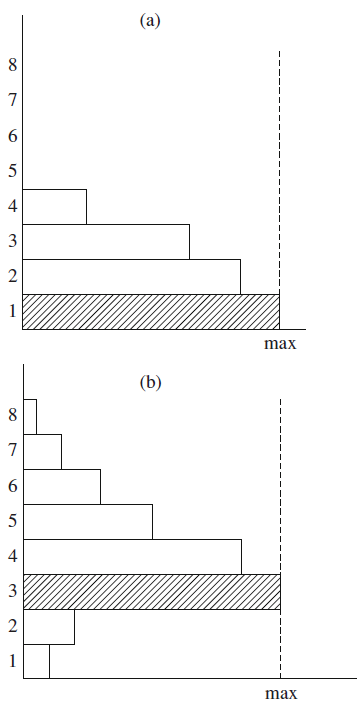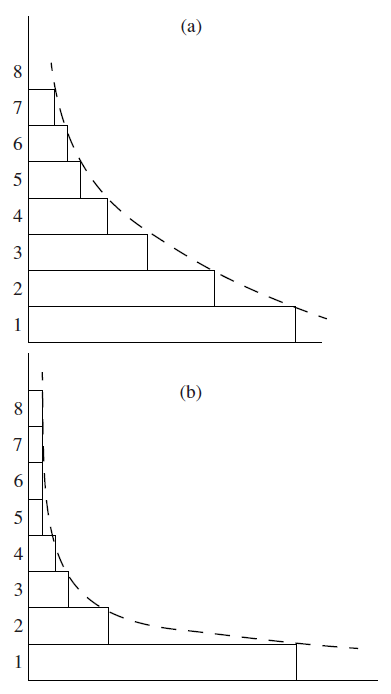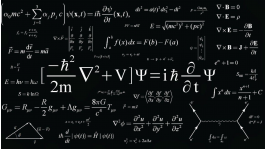Hyperbolic distribution as the main law of structuring complex systems
Any complex system builds itself by the level of complexity of its components. Note that systems contain few complex components and many simple ones. As a result, the structure of a system is described as a hyperbolic curve (H curve). The description of complex systems by means of the H curve is universal and may be viewed as equally just for the distributions of galaxies in the universe, biological populations, income groups in society, or machines in factories [1].
Some researchers stress both similarities and differences between simple and complex systems. For example, complex systems are capable of evolving, i.e., complicating their organization. It is believed that the parameters of simple systems are distributed in compliance with the Gaussian (normal) distribution, while those of complex systems, according to the Pareto (hyperbolic) distribution. The more complex the system and its evolutionary capabilities, the more “non– Gaussian” its characteristics are [2]. It is safe to say that in the course of their progressive evolution, systems “self–assemble” by the level of complexity of their components. Moreover, several authors even tried to show that normal and hyperbolic distributions may “contact” at the point of the golden ratio, which, in turn, acts as a “gate” from the region where development is absent to the region where it is present (2, p. 21). Respectively, the more proportions of the golden ratio present in a system, the higher its evolutionary potential. In humans, the number of golden ratio proportions is higher than in any other natural beings. This fact determines the colossal possibilities for the development of humans and human society.
Hyperbolic distribution is usually described by the Pareto function and has the following form: Y = αX–β, where α > 0 and β > 0 are parameters of the process [2].
In a number of works, this law of distribution is specified. For example, in technological systems, the following rule, which has been formulated by B.I. Kudrin, is effective: a system is stable if 5 to 10% of products belong to “Noachian” (rare) groups embracing 40–60% of its species composition, while 40–60% of products fall on “locust” (mass) groups covering 5–10% of species [1]. There are data showing that this rule is just not only for technological but also for biological and social systems.
The fact that complex systems are capable of self–organization according to the hyperbolic law means that they have fractal properties. In other words, systems of different levels of aggregation imitate each other’s structure because they are based on the same principle of formation. Can we trace this fractal property for a human being and society, and, if yes, on what is it based? Still another question is what logic underlies the interface of micro (individual) and macro (social) regularities. The latter question may be formulated in the following way: how do the evolution of the individual and the evolution of society correlate? Let us try to answer this question in terms of the psychological theory of circuits and the economic theory of vital resources.
Human mental profile
There is a well–known notion of personality profile in psychology, and it is effectively used in the theory of mental circuits. According to R. Wilson’s classification, the human mental component may be represented by an eight–circuit model, which includes the following circuits: oral (biosurvival), anal (emotional–territorial), semantic (dexterity–symbolism), moral (social–sexual), holistic (neurosomatic), collective (neurogenetic), metaprogramming, and nonlocal (quantum) [3].
Each circuit manifests a definite stage of personality formation, while the presence of an individual at a definite circuit characterizes his or her mental state. The higher the circuit, the higher his or her mental evolution. Since different life problems relate to different mental circuits, the individual has to “travel” over them [4].
To determine the mental level of an individual, it is necessary to use the notion of mental profile, which includes the distribution of human vital resources (money, energy, knowledge, and time [5]) over the eight mental circuits. With account for the mutual correlation of the vital resources, it is possible to use a simplified interpretation: the distribution of the individual’s time during which he or she stays at each of the mental circuits. Ladder diagrams of the mental profiles of two personality types are shown in Fig. 1.

Fig. 1. Human mental profile. (a) Regressive (hominid), (b) progressive (posthominid).
In practice, we can construct mental profiles only of those people about whom we have detailed and reliable information. Hence, it is advisable to use a simplified technique when only one dominant circuit [1], at which the individual in question stays longer than at the others, is under study.
In Fig. 1a, the first circuit is dominant, while in Fig. 1b, the third one is (the shaded portions). This means that the individual presented by Fig. 1a is primarily at the biosurvival circuit and spends his or her active life mainly finding means of subsistence, while the individual presented by Fig. 1b is at a higher level of development (semantic circuit), improving, for example, his or her professional skills and knowledge.
Differences in personal mental profiles are of great importance because all interactions in society are in accordance with the simple laws of circuit interfaces formulated by Ya.A. Fel’dman. When two individuals interact with the circuits i and j, three interface scenarios are possible: if the level of the circuits in these two individuals is the same (i = j), competition takes place; if the circuits are neighboring (|i – j| = 1), cooperation is observed, which helps the representative of the higher circuit control the representative of the lower one; finally, if the circuits are very different (|i – j| > 1), the representative of the lower circuit is aggressive relative to the representative of the higher one [6, p. 16]. The latter is observed only under a direct contest between representatives of two different circuits; otherwise, the individual at the higher circuit usually wins [8].
Another regularity is the eagerness of the individual to be mainly at the highest mental circuit among his or her developed ones. In other words, if an individual has developed the third (semantic) circuit to a sufficient extent, he or she will prefer to spend as much time as possible at this circuit rather than at the first (biosurvival) or second (emotional).
The above property has a far–reaching effect because each circuit implements a very strict dichotomy of the population into two groups: people who have “passed” the respective circuit and people who remain “arrested” at it. As an example, let us consider the third (semantic) circuit and its role in the formation of the structure of society. This consciousness circuit is connected with mastering language, speech, and logical thinking. Upon developing this circuit, individuals may further develop their intellectual potential; otherwise, they find themselves at the “social bottom,” where no intellectual achievements are necessary. The higher the semantic barrier created by language and to be overcome, the harder the dichotomy. According to N.N. Vashkevich, an unorganized illogical language polarizes the intellect of an ethnos: there are many very intelligent and many very stupid people in society [9, p. 196]. The principle that underlies this polarization is simple: people who have managed to “force their way” through a difficult and badly structured language easily overcome primitive logical constructions and are prepared to obtain knowledge under any conditions; meanwhile, people who have stumbled over language difficulties and failed to overcome them are helpless in solving nonstandard logical problems.
The mental profile of society
Since every person has his or her mental profile determined by the dominant mental circuit, all members of society may be ranked according to this profile: one part of society will find itself at the first circuit; another part, at the second; and so on. The distribution of individuals by level of development specifies the mental profile of society, showing how many people there are at the upper and lower circuits. As a rule, the lower the circuit, the higher the number of its representatives. The diagram of this distribution has the form of a ladder (Fig. 2). Upon joining the values of all the circuits by a respective line, we obtain a hyperbolic curve. Society turns out to be stratified depending on the mental level of its members.

Fig. 2. Mental profile of society. (a) Normal, (b) regressive.
For a better definiteness, we may use the simplified notion of the mental profile, when only one dominant (leading) group is singled out instead of studying the whole distribution of social groups. In Fig. 2, this is the group of persons at the first (biosurvival) circuit. This pattern helps coordinate the individual and social levels in determining their intellectual development. In other words, the theory of mental circuits may be projected to and generalized at the macrolevel.
A peripheral conclusion from the theory of circuits is the presence of stratification subordinate to the H distribution of social groups in a system. This conclusion largely explains different social and economic distributions. For example, the Lorenz curve, which describes population distribution by income level, is subordinate to the hyperbolic law. This curve may be modified. In particular, the diagram of per capita investment index with regard to the Russian regions shows that foreign and domestic investments are concentrated mainly in Moscow, St. Petersburg, and regions that extract raw materials for export [10]. It is reasonable to suggest that all hyperbolic distributions are based on the respective distribution of persons with different mental profiles.
Upon establishing the regularity of H distribution in social systems, let us pose a question about its geometric properties. What should the knee of the curve be like, i.e., what is the concentration of social groups at each level? Can we say that there is a certain “right,” or natural, form of this curve?
Some works postulate that a deviation of the actual parameters of the H curve from certain equilibrium proportions leads to an increase in the number of problems in the development of systems [1]. Some authors are of the opinion that the number of people at each higher circuit is two times lower than at the preceding one. According to Wilson, about 2% of the population is at the eighth circuit; 3%, at the seventh; 5%, at the sixth; 20%, at the fifth; about 40%, at the third and fourth; and still another 40%, at the first and second [3]. In addition, some authors believe that evolution implies an increase in the complexity and a decrease in the volume of evolving matter. For example, the mass of nonliving matter is an order of magnitude higher than that of living matter and two orders of magnitude higher than the mass of sapiens matter (the first four mental circuits). Only one–tenth of the population can transfer to the level of superconsciousness (the eighth circuit) [8].
All these suggestions mean the following. A deviation from the “right,” or natural, form of the H curve, which is the ideal model of development, leads to an increase in the number of evolutionary problems. At present, attempts are being made to find the “ideal”; however, nobody has succeeded in finding its recognized and universal variant to date. Yet this does not change the main point: society is stratified according to hyperbolic laws.
Since the stratification of society is based on differences between individual mentalities, the search for the ideal H distribution is limited. With time, a larger number of individuals are supposed to transfer to higher mental circuits; i.e., the share of highly developed persons is supposed to grow in the future. This is the positive evolution of society. In this case, the form of the H curve will also evolve to decrease its dip. Consequently, the “normal” form of the hyperbolic curve will be different at different periods.
A.Toffler’s waves and the megaeconomic interiorization of the mental circuits
According to the hypothesis of cross-circuit relations, every person overcomes his or her hominid circuits by means of interiorization [11]. A similar process is effective at the megalevel–within the entire socioeconomic system of the world.
The famous futurist Toffler singles out three waves of civilization in the development of society: the first is agricultural (agrarian) society, the second is industrial society, and the third is information society (the knowledge economy) [12]. Switches from one wave to another manifest qualitatively new stages in the development of humanity. Let us trace how these waves correlate with the mental circuits and vital resources.
The first (agrarian) wave created a certain agricultural surplus in society. The economy, as such, developed and acquired its inherent instrument of payment, money. This was when the conscious and purposeful economic life of humankind began and led to the subsequent development of crafts and science. The ultimate result of the first wave was mastering the food resource. Money and agricultural food products came to every household. The food resource is basic for survival and corresponds to the first (biosurvival) mental circuit. In fact, upon entering the first wave of civilization, humanity activated globally the first mental circuit when the survival of Homo sapiens as a biological species became a problem of global importance. In addition, according to the theory of vital resources, money also corresponds to the first mental circuit. Indeed, the very presence of the surplus of food led to the necessity and possibility of its exchange; capture; and, finally, sales and buys. That was the time when the modern monetary system began to form.
The second (industrial) wave led to mastering the energy resource. The industrial revolution launched the mastering of natural energy and the transition from manual labor to mechanization. From that moment, economic life started to accelerate, and sciences and technologies began to develop rapidly. As a result, the energy resource was mastered. Energy in the form of light (electricity) and heat (heating systems) came to every household. Since energy is the second vital resource, which corresponds to the second (emotional–territorial) mental circuit, we may state that upon entering the second wave of civilization, humankind globally activated the second mental circuit. The logical consequence of the formation of energy civilization was struggle between nations and countries, which resulted in numerous destructive wars. Among the positive consequences of the second wave, we should mention mastering space: distance ceased to impose principal limitations on social progress.
The third (information) wave has led to mastering an immaterial resource–knowledge. Since knowledge is the third vital resource, which corresponds to the third (semantic) mental circuit, we may state that, upon entering the third wave of civilization, humankind globally activated the third mental circuit.
At present, the world is still assimilating possibilities hidden in this wave; it is too early to speak about the fourth wave of civilization. However, with account for the idea of the fourth vital resource (time) and the specifics of the respective fourth (social–sexual) mental circuit, responsible for the formation of horizontal connections between people, it is possible to present a general futurist outlook. Most likely, owing to mass technologies, it will become possible to establish interaction between people very quickly. Rudiments of this process can be traced today in online communication; apparently, it will be qualitatively improved in the future.
Thus, at the same mental circuit, the individual and society use the same vital resources according to the same rules.
What is the essence of the model showing how waves of civilization are formed? In our opinion, it shows clearly how the four hominid circuits of human psyche are interiorized and overcome [13]. For example, upon understanding the structure of natural food chains, humanity managed to single out the most important among them and to “grow out” of them through liquidating food deficit and overcoming the first (biosurvival) circuit. Simultaneously, it invented money, and the world transferred to a qualitatively new stage of development. At the second stage, an energy deficit became evident; it was liquidated owing to the discovery of the steam engine and the combustion engine and, later, more sophisticated methods of extracting and processing natural energy. At that stage, humanity interiorized the second (territorial) mental circuit with its characteristic hierarchical structures and vertical relations. The third stage saw the formation of the most complicated scientific theories and the dissemination of information. Knowledge deficit was overcome, and the third (semantic) circuit was interiorized successfully. Today, colossal work is being conducted to build complex social and economic networks whose elements interact practically in a flash. Apparently, humanity is going to liquidate the time deficit and interiorize the fourth (social–sexual) mental circuit with its characteristic horizontal relations. Probably, this will lead to a fundamental change in all human mental capabilities and to the rise of Homo intivitus (intuitive) [8].
The concentration of vital resources and its importance for the evolution of a social system
The interiorization of the mental circuits and vital resources takes not only the form of waves of civilization but also the form of local tides.
The evolutionary logic of a country’s regional development may be presented as follows. The first stage of development implies the concentration of vital resources. During this period, capital and labor accumulate on definite conveniently located areas that form towns. Huge amounts of vital human resources, such as money, energy, knowledge, and time, become concentrated on relatively small areas. As a rule, this process completes with the formation of megalopolises, characterized by the maximum territorial density of the vital resources. The tendency to concentration is due to the lack of vital resources and the willingness to unite them. However, this process is finite; when the “overaccumulation” of the vital resources results in the formation of a complex system with a large number of connections, people try to interiorize their habitat.
If interiorization is successful, a new model of public existence is formed, from which all unnecessary connections are removed. The opposite tendency begins to form, i.e., the tendency to dissipate the vital resources. Economic agents become so efficient in using these resources that they are able to overcome the deficit and to distribute themselves in space more harmoniously. At this stage, megalopolises and large cities “scatter,” and people distribute themselves uniformly over small towns and settlements [14].
The stage of concentrating the vital resources shows that the hominid mental circuits are activated and makes it possible to solve key problems of these lower levels of human consciousness. Indeed, it is much easier to survive, succeed in life, acquire knowledge, and, finally, interact horizontally with other people in megalopolises. However, megalopolises are characterized by a great number of factors that hinder harmonious life. Hence, the process of interiorization implies acquiring the skills of utilizing effectively the vital resources and subsequently rejecting undesirable elements typical of life in overpopulated cities. After interiorization, the stage of vital resource dissipation begins, which manifests the beginning of mastering the posthominid mental circuits. During this stage, the most important achievements in the spiritual sphere become possible.
We have considered concentration and dissipation in the example of structuring a country’s economic space. Meanwhile, this machinery works for industrial structures as well. For example, the evolutionary theory of economic policy also singles out two lines of development [15–17]. The first line implies an increase in the economy’s heterogeneity and consists of two stages: import substitution, when sufficiently strong firms appear in a country, which can replace foreign producers; and the beginning of export–oriented growth, when companies can compete even in the world market. Centers of accumulating the vital resources of society are formed. The second line is associated with the growth of the economy’s homogeneity and also includes two stages: stimulation of rapid development at the expense of innovations and a higher role of knowledge and the formation of a developed market based on small and medium business. At these stages, vital resources dissipate uniformly among compact but highly efficient companies. Thus, industrial and territorial machineries of the evolution of a vital resource system may be viewed as identical.
The overlapping of the waves of civilization and the vital resource concentration–dissipation machinery may be arbitrarily diverse. It is difficult to establish stable models in this respect; however, they are based on the same laws.
Evolution as a tool to interiorize functional relations
Personality evolves at moments when reality is rethought cardinally. This process may be divided into the following stages: differentiating the system’s existing relations into functional (important, substantial) and secondary (unimportant, unnecessary); ignoring (rejecting) secondary relations and, as a consequence, overcoming the deficit of the vital resources; and modeling functional relations, which implies representing the system in an abstract and idealized form. Upon completing interiorization, the individual automatically rises over the system under review, as if growing out of it; at the same time, he or she implements the new model (system) of existence in his or her life [13].
A number of points with regard to this process require discussion. How can we determine which relations are functional and which are secondary? What are the criteria of identifying functional relations?
The answer is simple enough: functional are relations that produce mental or physical activity and make the individual’s inner organization more complex. In fact, these relations stimulate the evolutionary growth of the individual.
We can use another criterion: functional relations lead to the emergence of new mental and material patterns. Either new knowledge or new material artifacts (goods, services) will appear. Otherwise, relations will be viewed as secondary and may be ignored.
Is this sufficient for a positive evolution of personality to determine functional and ignore secondary relations? If no, what else is necessary?
Indirectly, these questions were answered by A. Maslow; he investigated the characters of outstanding personalities, such as B. Spinoza, T. Jefferson, A. Lincoln, A. Einstein, and others. Maslow discovered that each of them had a very narrow circle of close friends and “cut off” superficial relations [18]. We may say that the evolution of personality implies not only the interiorization of functional relations but also their intensification. After this, they are ultimately interiorized (modeled); then, transfer to the next mental circuit takes place.
In going “upstairs” along the sequence of the mental circuits, the motivation system, implemented in the life goal posed by the individual, is of great importance. If it is a goal of the second circuit, the individual will hardly go beyond the hominid circuits; if the individual has posed a goal of, say, the seventh circuit, he or she has a good chance to reach the posthominid level. The life goal specifies the vector of individual evolution and predetermines successes and failures for the whole life journey.
As individual strategies aggregate, a megatendency emerges to transform society and change it in one direction or another depending on the representatives of which circuits prevail in it.
A very interesting aspect becomes evident in this context. The point is that all developed religious doctrines postulate that the main goal is reaching the divine state of human consciousness, which will open new forms of information interaction between the individual and the world. This goal corresponds to the eighth, the highest, mental circuit and specifies the most powerful and correct vector of personal development. Ancient spiritual doctrines, such as Yoga and Sufism, pose similar goals.
In conclusion, I would like to stress that the theory of mental circuits has its prototypes in ancient religious and philosophical systems. For example, the four Indian castes cover the eight circuits: the Shudras (physical work), the Vaishyas (mental work), the Kshatriyas (the use of will), and the Brahmins (the use of spirit) [20]. The well–known eight–step Patanjali Yoga system and the Noble Eightfold Path of Buddhism intersect with the eight mental circuits [20]. To all appearances, the eight–level pattern of the human psyche may already be viewed as an artifact.
References
1. B.I. Kudrin, Technetics: A New Paradigm of Technique Philosophy (the Third Scientific Worldview) (Tomsk Univ., Tomsk, 1998) [in Russian].
2. A.I. Ivanus, The Da Vinchi Code in Business or Harmonic Management According to Fibonacci (LENAND, Moscow, 2005) [in Russian].
3. R.A. Wilson, Evolutionary Psychology (Primer, New York, 1995).
4. R.A. Wilson, Quantum Psychology (Tempe, Arizona, USA, 1990).
5. E.V. Balatskii, “Theory of Life Resources: Models and Empirical Estimates,” Monitoring Obsh. Mneniya, No. 2 (2007).
6. Ya.A. Fel’dman, Theory of Human Levels and Model (Dobroe Slovo, Moscow, 2005), p. 17 [in Russian].
7. H. Gardner, Frames of Mind: The Theory of Multiple Intellegences (Basic Books, New York, 1983).
8. The Third Instinct (http://instinct3.narod.ru).
9. N.N. Vashkevich, Behind Seven Seals. The Mysteries of Language Origin. Biblical Symbols. Russian Phraseology (Belye Al’vy, Moscow, 2004) [in Russian].
10. G.P. Litvintseva, “Investment Crisis as a Result of a Mismatch between the Structural and Technological Characteristics of the Economy and Its Institutional Setup,” Probl. Prognoz., No. 6, 38 (2003) [Studies Russ. Econ. Develop. 14 (6), 560 (2003).
11. E.V. Balatskii, “Cross–Circuit Relations in the Human Psyche,” Vestn. Ross. Akad. Nauk, No. 12 (2007) [Her. Russ. Acad. Sci., No. 6 (2007)].
12. A. Toffler and H. Toffler, Revolutionary Wealth, 1st ed. (Knopf, New York, 2006).
13. E.V. Balatskii, “Vital Resources and Contours of Consciousness,” Vestn. Ross. Akad. Nauk, No. 6 (2008).
14. E.V. Balatskii and A.B. Gusev, “Syndrome of Capital Megalopolis in the Russian Economic Landscape,” Prostranstv. Ekon., No. 4 (12) (2007).
15. V. Polterovich and V. Popov, “Four Stages of Modernization,” Kommersant, May 10 (2006).
16. V.M. Polterovich and V.V. Popov, “Evolutionary Theory of Economic Policy: Part 1: Experience of Rapid Development,” Vopr. Ekon., No. 7 (2006).
17. V.M. Polterovich and V.V. Popov, “Evolutionary Theory of Economic Policy: Part 2: The Necessity of Timely Switching,” Vopr. Ekon., No. 8 (2006).
18. B. Werber, L’Encyclopedie du savoir relatif et absolu, (1993).
19. E.V. Balatskii, “Auxiliary Imprints and Human Behavior,” Vestn. Ross. Akad. Nauk, No. 10 (2007) [Her. Russ. Acad. Sci., No. 5 (2007)].
20. Paramahansa Yogananda, Autobiography of a Yogi (Crystal Clarity, 2005).
[1] While diagnosing the mental profile of an individual, some researchers consider several circuits. For example, Ya.A. Fel’dman proceeds from the presence of three “favorite” circuits in every individual, two of which are alternately chief and responsible for choosing a goal, while the third is auxiliary and responsible for choosing means to accomplish this goal [6]. This approach appears unreasonably complicated. Other authors study the cognitive profile. For example, H. Gardner uses this notion within the framework of his theory of multiple intelligences [7] while considering the linguistic, musical, logical–mathematical, spatial, bodily–kinetic, intrapersonal, and interpersonal types of the mind.
Official link to the article:
Balatskii Е.V. Mental Circuits, Society Stratification, and Civilization Waves// «Herald of the Russian Academy of Sciences», 2008, Vol. 78, No. 4, pp. 377–382.









